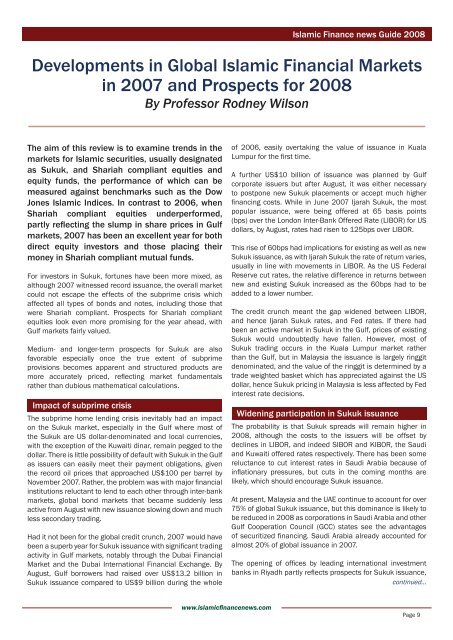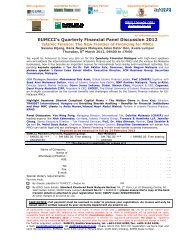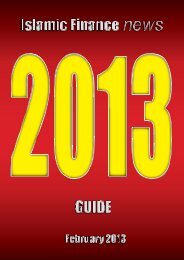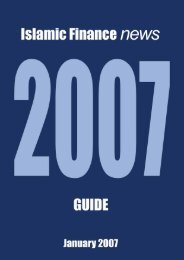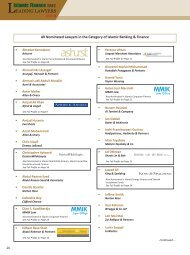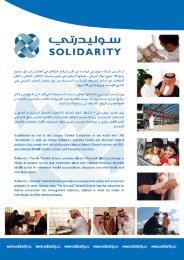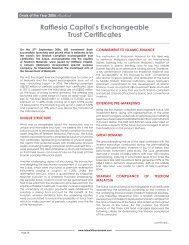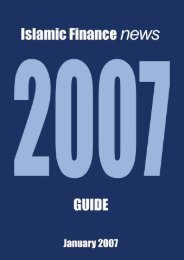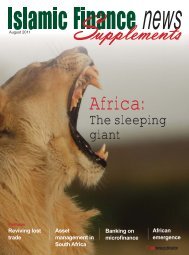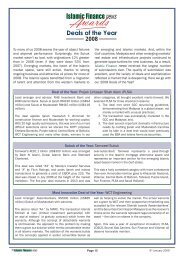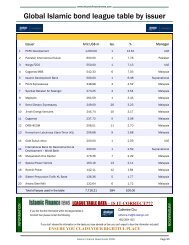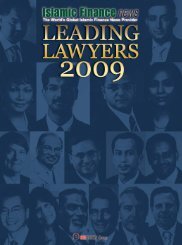Create successful ePaper yourself
Turn your PDF publications into a flip-book with our unique Google optimized e-Paper software.
www.islamicfi nancenews.com<br />
<strong>Islamic</strong> <strong>Finance</strong> news Guide 2008<br />
Developments in Global <strong>Islamic</strong> Financial Markets<br />
in 2007 and Prospects for 2008<br />
By Professor Rodney Wilson<br />
The aim of this review is to examine trends in the<br />
markets for <strong>Islamic</strong> securities, usually designated<br />
as Sukuk, and Shariah compliant equities and<br />
equity funds, the performance of which can be<br />
measured against benchmarks such as the Dow<br />
Jones <strong>Islamic</strong> Indices. In contrast to 2006, when<br />
Shariah compliant equities underperformed,<br />
partly refl ecting the slump in share prices in Gulf<br />
markets, 2007 has been an excellent year for both<br />
direct equity investors and those placing their<br />
money in Shariah compliant mutual funds.<br />
For investors in Sukuk, fortunes have been more mixed, as<br />
although 2007 witnessed record issuance, the overall market<br />
could not escape the effects of the subprime crisis which<br />
affected all types of bonds and notes, including those that<br />
were Shariah compliant. Prospects for Shariah compliant<br />
equities look even more promising for the year ahead, with<br />
Gulf markets fairly valued.<br />
Medium- and longer-term prospects for Sukuk are also<br />
favorable especially once the true extent of subprime<br />
provisions becomes apparent and structured products are<br />
more accurately priced, refl ecting market fundamentals<br />
rather than dubious mathematical calculations.<br />
Impact of subprime crisis<br />
The subprime home lending crisis inevitably had an impact<br />
on the Sukuk market, especially in the Gulf where most of<br />
the Sukuk are US dollar-denominated and local currencies,<br />
with the exception of the Kuwaiti dinar, remain pegged to the<br />
dollar. There is little possibility of default with Sukuk in the Gulf<br />
as issuers can easily meet their payment obligations, given<br />
the record oil prices that approached US$100 per barrel by<br />
November 2007. Rather, the problem was with major fi nancial<br />
institutions reluctant to lend to each other through inter-bank<br />
markets, global bond markets that became suddenly less<br />
active from August with new issuance slowing down and much<br />
less secondary trading.<br />
Had it not been for the global credit crunch, 2007 would have<br />
been a superb year for Sukuk issuance with signifi cant trading<br />
activity in Gulf markets, notably through the Dubai Financial<br />
Market and the Dubai International Financial Exchange. By<br />
August, Gulf borrowers had raised over US$13.2 billion in<br />
Sukuk issuance compared to US$9 billion during the whole<br />
of 2006, easily overtaking the value of issuance in Kuala<br />
Lumpur for the fi rst time.<br />
A further US$10 billion of issuance was planned by Gulf<br />
corporate issuers but after August, it was either necessary<br />
to postpone new Sukuk placements or accept much higher<br />
fi nancing costs. While in June 2007 Ijarah Sukuk, the most<br />
popular issuance, were being offered at 65 basis points<br />
(bps) over the London Inter-Bank Offered Rate (LIBOR) for US<br />
dollars, by August, rates had risen to 125bps over LIBOR.<br />
This rise of 60bps had implications for existing as well as new<br />
Sukuk issuance, as with Ijarah Sukuk the rate of return varies,<br />
usually in line with movements in LIBOR. As the US Federal<br />
Reserve cut rates, the relative difference in returns between<br />
new and existing Sukuk increased as the 60bps had to be<br />
added to a lower number.<br />
The credit crunch meant the gap widened between LIBOR,<br />
and hence Ijarah Sukuk rates, and Fed rates. If there had<br />
been an active market in Sukuk in the Gulf, prices of existing<br />
Sukuk would undoubtedly have fallen. However, most of<br />
Sukuk trading occurs in the Kuala Lumpur market rather<br />
than the Gulf, but in Malaysia the issuance is largely ringgit<br />
denominated, and the value of the ringgit is determined by a<br />
trade weighted basket which has appreciated against the US<br />
dollar, hence Sukuk pricing in Malaysia is less affected by Fed<br />
interest rate decisions.<br />
Widening participation in Sukuk issuance<br />
The probability is that Sukuk spreads will remain higher in<br />
2008, although the costs to the issuers will be offset by<br />
declines in LIBOR, and indeed SIBOR and KIBOR, the Saudi<br />
and Kuwaiti offered rates respectively. There has been some<br />
reluctance to cut interest rates in Saudi Arabia because of<br />
infl ationary pressures, but cuts in the coming months are<br />
likely, which should encourage Sukuk issuance.<br />
At present, Malaysia and the UAE continue to account for over<br />
75% of global Sukuk issuance, but this dominance is likely to<br />
be reduced in 2008 as corporations in Saudi Arabia and other<br />
Gulf Cooperation Council (GCC) states see the advantages<br />
of securitized fi nancing. Saudi Arabia already accounted for<br />
almost 20% of global issuance in 2007.<br />
The opening of offi ces by leading international investment<br />
banks in Riyadh partly refl ects prospects for Sukuk issuance,<br />
<strong>continued</strong>...<br />
Page 9


